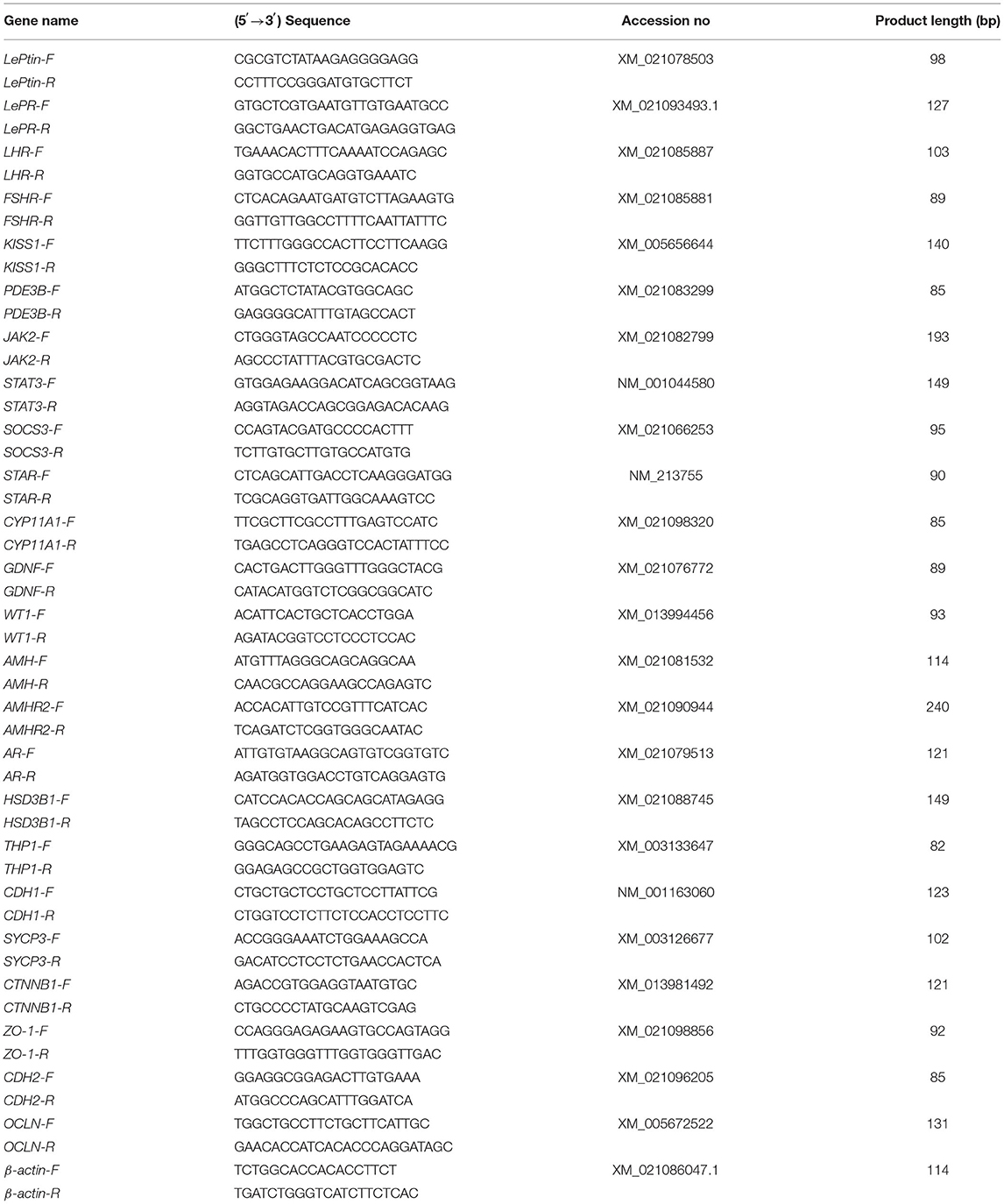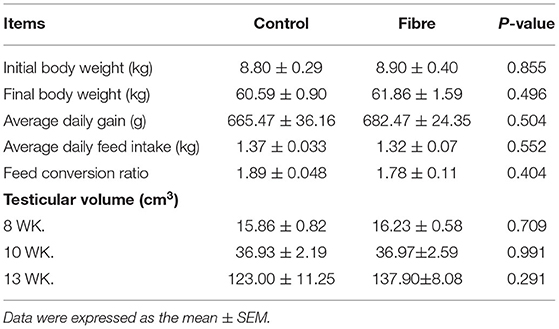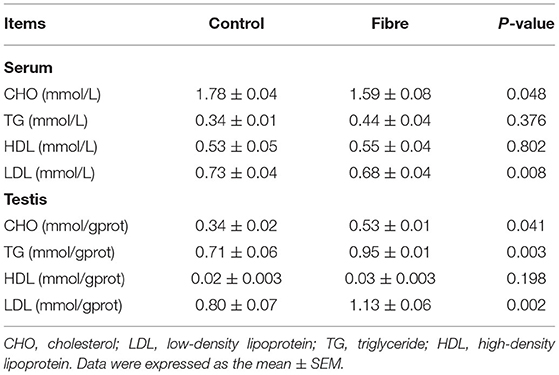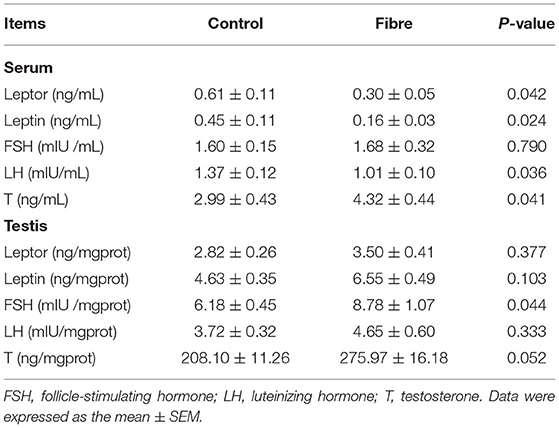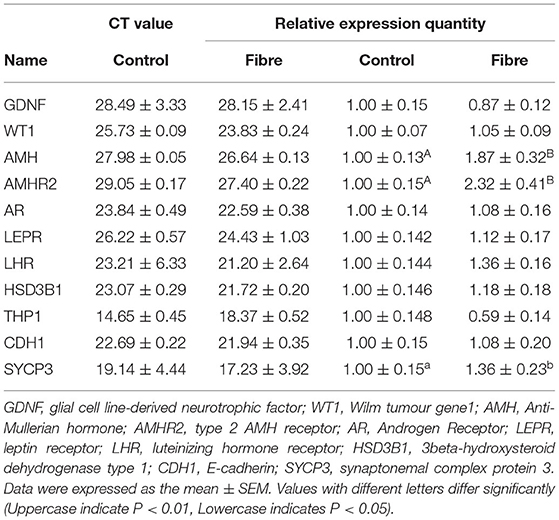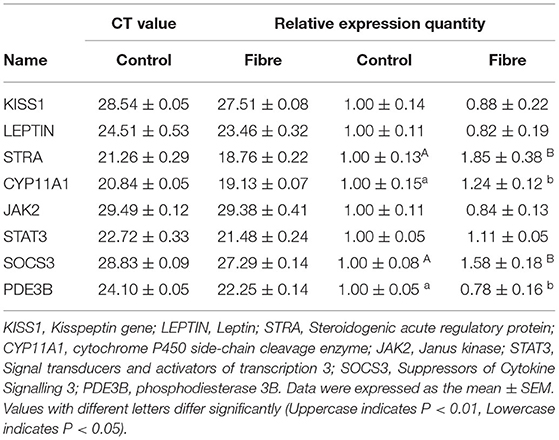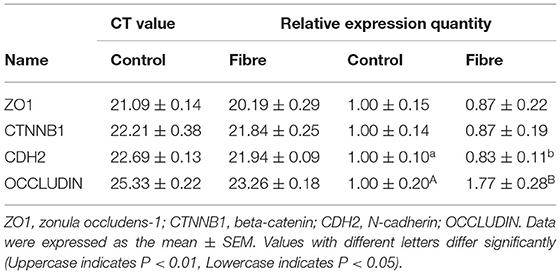- 1Key Laboratory of Animal Disease-Resistance Nutrition and Feed Science, Ministry of Agriculture, Sichuan Agricultural University, Chengdu, China
- 2Key Laboratory of Animal Disease-Resistance Nutrition, Ministry of Education, Chengdu, China
- 3College of Life Science, Sichuan Agricultural University, Ya'an, China
Testicular development is imperative to spermatogenesis, and pre-puberty is the key period for testis development. This study, therefore, investigated the effects of fibre supplementation on testis development and its possible mechanism in a growing boar model. Thirty Yorkshire boars were randomly divided into a control group (Control) and a fibre group (Fibre) from day 0 to 90 after weaning, with three pigs per pen and five pens per treatment. Blood and testes were collected for analysis. Dietary fibre supplementation had no significant effect on growth performance, testicular volume, or libido but increased the semen production of boars. Boars fed with fibre had lower serum cholesterol (CHO) and low-density lipoprotein (LDL) levels compared to those on the Control diet; however, testicular CHO, triglyceride (TG), and LDL concentration in the Fibre group were significantly higher than the Control group (P < 0.01). Testicular histological analysis showed that seminiferous tubules and testicular germ cells of 120-day-old boars were densely arranged in the Fibre group, and the number of Leydig cells was significantly higher than that of the Control group (P < 0.001). Furthermore, the diet supplemented with fibre significantly decreased leptin, leptin receptor (Leptor), and luteinising hormone (LH) concentrations in boar serum (P < 0.05), whereas follicle-stimulating hormone (FSH) and testosterone concentrations were significantly increased (P < 0.05). Meanwhile, the expression of AMH, AMHR2, and SYCP3 genes related to proliferation and differentiation, and hormone-related genes STAR and SOCS3, were significantly up-regulated (P < 0.05). OCCLUDIN expression was up-regulated, whereas CDH2 expression was down-regulated. In conclusion, increased fibre intake during the pre-puberty period in growing boar is crucial for Leydig cell proliferation, up-regulating the expression of genes related to hormone synthesis and thereby promoting the secretion of testosterone and semen production.
Introduction
The testis is an important sexual organ in male animals. In humans and other male mammals, such as rats and boars, testicular development directly affects semen quality (1, 2), which is crucial for reproduction. After birth, testicular development mainly occurs in the seminiferous tubules, including the proliferation of Sertoli, germ, and Leydig cells. Human testes mainly develop during childhood (2–11 years) and adolescence (2–14 years) (3). From 2–8 years of age, the number of germ cells increases by 3 to 6 times, and testis volume, testis weight, Sertoli cells, and testosterone levels in the testes gradually increase (4); subsequently, the spermatogonial cells proliferate rapidly. Testicular development of boars is similar to that of humans and can be divided into two key stages. During the pre-puberty period, the number of germ cells increases, and boars nearly reach sexual maturity at approximately 120–150 days. Therefore, testicular development during the growing period is very important for later spermatogenesis.
As an important nutrient, it is believed that fibre intake may have beneficial effects on reproduction and health. However, there is still little direct evidence of its effect on testicular development and spermatogenesis. It has been reported that sperm concentration and motility in humans are positively influenced by cereal consumption, and vegetables and fruits also have a great effect on sperm motility. These substances contain a higher level of dietary fibre (5). Studies in rabbits have shown that the addition of dietary fibre (hemicellulose and soluble fibre) with moderate feed intake restriction decreased sperm abnormalities and increased the percentages of normal and motile spermatozoa and the insemination ratio (6). Increased fibre intake can improve sex hormone-binding globulin levels, thereby affecting the activity of related sex hormones involved in testicular development. The dietary pattern, which was high in vitamins, dietary fibre, and polyunsaturated fatty acids, was significantly associated with a lower risk of asthenozoospermia (7). Our previous study in mice and pigs demonstrated that fibre supplementation regulates animal reproduction by affecting hormone secretion and nutrient metabolism (8) and that dietary fibre supplementation during pregnancy improved testicular development in the offspring boars (9). The above results suggest that fibre plays a positive role in boar reproduction and may be a useful nutrient for improving male fecundity. As we know, testicular development of boars before sexual maturity is very important for spermatogenesis in adulthood. The decrease of germ cell numbers induced by Bisphenol A in mice or heat stress is accompanied by the decrease in spermatogenesis (10, 11). However, it is not clear whether supplementary fibre during pre-puberty benefits testicular development and semen production in boars. Therefore, growing boars were used as an experimental animal model in this study to investigate the effect of fibre supplementation on testicular development and possible mechanisms.
Materials and Methods
Experimental Animals and Design
Thirty healthy Yorkshire purebred boars with similar body weights (8 ± 0.46 kg) were selected and randomly divided into two groups: control (Control) and fibre (Fibre). There were three pigs per pen and five pens per treatment. Feed was prepared according to the principle of equal energy and nitrogen, with inulin and wheat bran as fibre sources. The diet formula was prepared according to the NRC 2012 (the nutritional levels of the diet are shown in Table 1).
Animal experiments were approved by the Sichuan Agricultural University under the Ethics Approval Code SCAUAC201906-03. Boars were raised in the teaching and scientific research farm and fed at 08:00, 14:00, and 20:00 each day, with free access to food and water. The initial and final body weights were recorded, and the feed intake was recorded daily. Other routine care, such as disinfection and immunity, was performed according to farm requirements.
After 120 days, the boars were fed the same diet and then trained at 6.5 months of age. Semen was collected once a week at 8 months for semen quality analysis.
Sample Collection
At 120 days of age, six boars in each group were fasted for 12 h with unlimited access to drinking water, followed by blood collection through the anterior vena cava. The blood sample was placed in a 1.5 ml EP tube for 30 min and then centrifuged for 10 min at a speed of 3,000 rpm. The supernatant was collected and stored at −20°C. Five boars in each group were selected for testis sampling following anaesthetization. The testes were removed and weighed. Testicular tissues with a size of 1 × 1 × 1 cm were selected and stored in 4% paraformaldehyde for 24 h for histological analysis. Other testicular tissues were stored at −80°C.
Growth Performance and Sperm Quality
Body weights and feed intake of the boars were recorded, and the average daily gain and average daily feed intake of each boar was calculated. Once a month, the testicular length, width, and thickness were measured with a Vernier calliper, and testicular volume was calculated using the ellipsoid formula.
Ejaculation response time and ejaculation duration were also measured (12). A computer-assisted sperm analysis (CASA) system was used to determine sperm motility and density. Total spermatozoa and effective spermatozoa per ejaculation were measured in reference to the calculation formula (13).
Analysis of Serum and Testicular Hormone and Metabolite Contents
Approximately 200 mg of testicular tissue was homogenised in a 2 mL centrifugal tube with 200 μL phosphate buffer. The supernatant was collected after centrifugation at 10,000 rpm for 30 min. The CHO, TG, HDL, and LDL contents of the testis supernatant and serum were detected using an automatic biochemical analyser (Hitachi 3100, Japan). The leptin, leptin receptor (Leptor), testosterone (T), FSH, and LH levels were determined using an enzyme-linked immunosorbent assay (ELISA) kit (Jiancheng Bio, Nanjing, China). Hormone detection was performed using the ELISA double-antibody sandwich method. The substrate TMB was used for colour development. There was a positive correlation between the colour and hormone concentration in the sample. The absorbance (OD) was measured by the microplate reader at a 450 nm wavelength.
Histological Examination of Testis Tissues
Testis fixed in 4% paraformaldehyde were embedded in paraffin, cut into 5-μm-thick slices, stained with haematoxylin and eosin after wax removal, and sealed with neutral gum. Five histological slides from each boar and 10 section per slide were counted morphometrically, and processed using an optical microscope with the software programme Image-Plus 6.0(Media Cybernetics Inc., USA). The number of Sertoli cell or Leydig cell was counted morphometrically and calculated as the number of per seminiferous tubule. Finally, a total of 500 cross-sections of seminiferous tubules per group were counted.
Gene Expression
Gene expression in the testes was assayed by fluorescence-based quantitative PCR. The primer information is shown in Table 2. Total RNA was extracted from 50 mg of testicular tissue using a total RNA extraction kit (Tianmo Biotech Co., Ltd., China). Reverse transcription was performed using the PrimeScript™ RT Reagent Kit with gDNA Eraser (TaKaRa, Japan). Fluorescence-based quantitative PCR (qRT-PCR) assays were performed using an ABI7900HT fast, real-time PCR system (Applied Biosystems, USA) with a 20 μL reaction volume of SYBR Green PCR Master Mix (TaKaRa). qPCR conditions were as follows: 94°C for 30 s, followed by 40 cycles of 94°C for 5 s, and 60°C for 30 s. Each sample was analysed in triplicate. The mRNA expression levels were normalised to β-actin and calculated using the 2–ΔΔCt method (14).
Statistical Analysis
Data was expressed as mean ± standard error and analysed using the SAS 9.4 software (SAS Institute Inc., Cary, NC, USA). If the measurement data conformed to the normal distribution, the independent sample t-test was used for analysis between the Control group and the Fibre group; otherwise, the non-parametric test was used. The level of statistical significance was set at P < 0.05.
Results
Growth and Testicular Development of Growing Boars
There were no significant differences in the average daily gain, average daily feed intake, feed conversion ratio, and testicular volume at each age between the Control and Fibre groups (P > 0.05), as shown in Table 3.
Sexual Desire and Spermatogenesis in Adult Boars
Semen was collected eight times to track the effect of fibre supply before sexual maturity on the reproductive performance of boars after sexual maturity. The results showed that the time to ejaculation was shortened by nearly 50 s, and the duration was prolonged by 30 s (P > 0.05) (Figure 1). Furthermore, the number of effective sperm in Fibre group boars was 16% higher than in the Control group (P < 0.05).
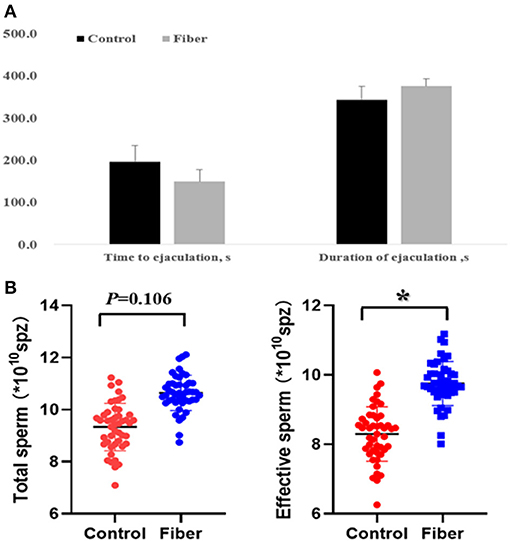
Figure 1. Effects of dietary fibre supplementation on libido and semen production of boars. (A) The boar libido performance, and data were expressed as the mean ± SEM. (B) The total sperm production and effective sperm production of boars. Data were expressed as the mean ± SEM. *P < 0.05.
Serum and Testis Metabolites
As shown in Table 4, dietary fibre supplementation influenced the lipid levels in the serum and testes of boars. Compared to the Control group, the CHO (P < 0.05) and LDL in the Fibre group were significantly decreased (P < 0.01), while the CHO (P < 0.05), TG, and LDL contents in the testis of the Fibre group were significantly higher than those in the Control group (P < 0.01).
Hormone Level in Serum and Testis
As shown in Table 5, dietary fibre supplementation has great effects on hormone levels in the serum and testes of boars. Compared with the Control group, the concentrations of leptin, leptor, and LH in the serum of the Fibre group were significantly lower (P < 0.05). Interestingly, the hormone levels in the testicular tissue were completely different from those in serum, and the FSH and T levels in the Fibre group were higher than those in the Control group (P < 0.10); however, there was no significant difference in the leptin and LH levels (P > 0.05).
Testicular Development and Morphology
As shown in Figures 2A,B, at the age of 120 days, the testicular structure of boars in the Control and Fibre groups was clear and complete, but the seminiferous tubules were loosely arranged in the Control group and were tightly arranged in the Fibre group. The germ cells in the Fibre group were closely arranged, and the number of germ cell layers and germ cells in the seminiferous tubules increased (Figures 2C,D). Furthermore, no significant difference was observed in the number of Sertoli cells, whereas the number of Leydig cells in the Fibre group was significantly higher than that of the Control group (Figure 3) (P < 0.001).
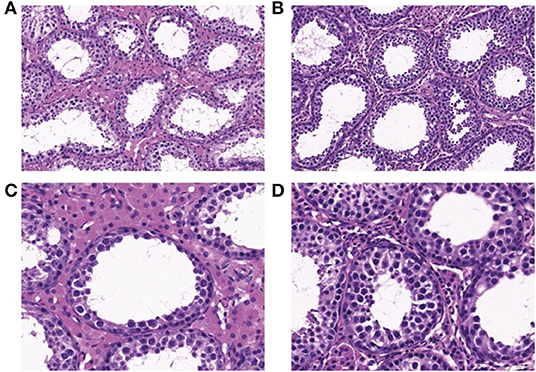
Figure 2. HE staining of testis tissue cross-sections of boars at 120 days. (A, C) Represent the Control group with a 200-fold field of vision; (B, D) Show the Fibre group with a 400-fold field of vision.

Figure 3. The number of germ cells in testes of boars. Leydig cell, No. of Leydig cells per tubule; Sertoli cell, No. of Sertoli cells per tubule. Data were expressed as the mean ± SEM. **P < 0.01.
Relative mRNA Expression of Testis
To verify whether the fibre supplementation influenced testicular development, the mRNA expression level of proliferation and differentiation genes were analysed (Table 6). The relative expression of AMH, AMHR2, and SYCP3 genes was significantly up-regulated in the Fibre group (P < 0.01 or P < 0.05).
As shown in Table 7, compared to the Control group, the expression of steroidogenic acute regulatory (StAR) protein and the suppressors of cytokine signalling 3 (SOCS3), a leptin-inducible inhibitor, were up-regulated in the Fibre group (P < 0.01). Meanwhile, the expression of cytochrome P450 family 11 subfamily A member 1 (CYP11A1) genes was significantly up-regulated (P < 0.05), and the relative expression of phosphodiesterase-3B (PDE3B) mRNA was significantly down-regulated (P < 0.05).
As shown in Table 8, the expression of the OCCLUDINS gene in the Fibre group was significantly up-regulated (P < 0.01), but the expression of CDH2 was significantly down-regulated (P < 0.05), and the expression of ZO-1 and CTNNB1 were not different.
Discussion
In this study, growing boars were used as a model to investigate the relationship between nutrition and testicular development. Pigs are an excellent large animal model for studies of human anatomy (15). However, both humans and pigs have poor fibre digestibility. In this study, we found that a total dietary fibre (TDF) difference of approximately 1.5–2.5% had no significant effect on the growth performance of growing boars. Research has shown that fibre supplementation in weaned piglets improves their growth performance (16), is beneficial to weaned piglet health, and reduces the diarrhoea rate (17). However, Asmus et al. found that fibre supplementation did not affect the growth performance of fattening pigs, such as the average daily gain and feed-meat ratio (18), and increased the ileal protein loss rate of the castrated boars with an increase in dietary neutral detergent fibre (NDF) levels (19). Different fibre sources have different fibre compositions and fermentation capacities that affect growth and reproduction differently (20).
We further investigated the role of fibre intake on the reproductive performance of adult boars and found that it had no effect on sexual desire but increased the number of effective sperms. There is little direct evidence regarding the effect of fibre on testicular development and semen quality. Research has shown that the total motile count (TMC) is significantly higher in men who consume more fruit, nuts, and vegetables (21). Restriction of feed intake and dietary fibre supplementation can improve sperm quality in adult male rabbits (6). In fact, research on women showed that partially hydrolysed guar gum supplementation helped to improve pregnancy success in women with infertility (22) and improved the reproductive performance of sows (23). These results show that dietary fibre supplementation has a beneficial effect on the reproductive performance of both females and males.
Sperm production has been shown to be affected by testicular development and hormone secretion. The testis mainly consists of Leydig cells, Sertoli cells, and the spermatogenic cells. In males, Leydig cells are the main producers of testosterone, which is essential for sex differentiation and spermatogenesis (24). Sertoli cells also respond to the pituitary hormones, such as FSH, to begin the process of spermatogenesis. They are also known as the nursemaid cells of the primary spermatogonia (25), and androgen receptors on Sertoli cells bind testosterone to further promote sperm maturation. Our results showed that the increase in fibre intake in growing boars promoted the proliferation of Leydig cells and increased the levels of T and FSH, implying that fibre supplementation improves testicular development, which is beneficial to spermatogenesis in adulthood. However, no treatment difference was observed in free testosterone levels in healthy adult men with hyperlipidaemia after consuming a soluble fibre or insoluble fibre diet (26), while a reduction in dietary fat intake and increase in fibre intake in men resulted in the reduction of the circulating androgen levels (27). A vegan diet is associated with small but significant increases in sex-hormone-binding globulin and testosterone concentrations compared with meat-eaters in men (28).
Cholesterol, the raw material for testosterone synthesis, participates in testosterone synthesis in the Leydig cells. Extracellular LDL can be degraded into cholesterol by lysosomes (29), and HDL is transported into cells through the scavenger receptor BI (SR-BI) to directly provide raw materials for testosterone synthesis (30). Testosterone synthesis was reduced owing to the decrease in free cholesterol content in rat Leydig cells (31). In this study, we found that increased fibre intake significantly increased the boar testicular cholesterol and T levels but reduced the serum cholesterol and T levels. Studies have shown that the consumption of high-fibre diets reduces serum lipid levels and total cholesterol content in humans (32) and animals (33). Dietary fibre supplementation in pregnant sows changes the development of piglet testes and increases the levels of CHO, TG, and HDL (8). After the intragastric administration of ginger extract to rats, an increase in testosterone levels in the serum and testes is accompanied by an increase in CHO levels (34). Therefore, it is speculated that testosterone in the testis may be positively correlated with cholesterol levels, and the increase in testicular cholesterol may be beneficial to male reproduction. However, the mechanism of inconsistent cholesterol and testosterone levels in the blood and testis is not clear and is worth exploring in the future.
The serum concentrations of leptin, leptin receptor, and LH were significantly decreased in this study. The leptin receptor is expressed in human and pig seminiferous tubules, germ cells, and sperm, suggesting that leptin plays an important role in male reproduction (35). Leptin is mainly synthesised and secreted by adipocytes and plays a crucial role in energy metabolism and reproduction by binding to its receptor LepR (36). The number of sperms in male mice decreased, and the proportion of abnormal sperms increased after the intraperitoneal injection of leptin (37). Leptin levels in adult men were negatively correlated with the free and total testosterone levels. Leptin increased by 1 ng/ml, and testosterone and free testosterone decreased by 5.13 and 0.11 ng/dl, respectively (38). In summer, mammalian testosterone synthesis and semen production decreases while leptin levels increase by 180% (39, 40). The above results indicate that leptin regulates testosterone secretion and sperm production and that excessive leptin has a negative impact on spermatogenesis and sperm quality.
Testicular steroidogenic enzymes, including StAR, 3β-HSD, and CYP11a1, play important roles in testosterone synthesis (41). Hormone synthesis in the testis is mainly regulated by the Janus kinase 2-steroidogenic acute regulatory (StAR)-suppressor of cytokine signalling 3 (JAK-StAT-SOCS3) signal pathway. In this study, we found that the expression of StAR, SOCS3, and CYP11a1 was up-regulated after an increase in fibre intake. Both StAR and CYP11A1 play critical roles in testicular development and spermatogenesis by regulating androgen production and are the rate-limiting factors of steroidogenesis (42), while SOCS3 is related to androgen production and sperm production in rats (43). Research has shown that diets supplemented with fruit pulp (44) or ellagic acid (45) improve reproductive function in male rats by increasing the circulatory levels of testosterone and up-regulating steroidogenic gene expression. Furthermore, dietary fibre intake up-regulated the expression of AMH and AMHR2. The secretion of anti-Müllerian hormone (AMH) by SCs is high from early foetal life to puberty (46). In postnatal life, AMH may play a role in regulating Leydig cell proliferation and androgen biosynthesis (47). AMH signals through its dedicated type II receptor, AMHR2, which is expressed in Leydig cells (48) and germ cells (49) and plays an important role in testicular development. AMH concentrations increase during puberty and are associated with testicular width in males (50). The expression of meiotic-related protein SYCP3 and tight junction OCCLUDIN play important roles in spermatogenesis; both genes were up-regulated after fibre intake. These results confirm that dietary fibre intake improves spermatogenesis by increasing the number of Leydig cells and strengthening testicular function.
Conclusion
In general, our results show that increasing fibre intake during the pre-puberty period increased sperm production in boars by increasing leydig cells and testosterone synthesis. These results provide important dietary guidelines for boars breeding before they reach sexual maturity.
Data Availability Statement
The datasets presented in this study can be found in online repositories. The names of the repository/repositories and accession number(s) can be found in the article/supplementary material.
Ethics Statement
The animal study was reviewed and approved by Animal experiments were approved by the Sichuan Agricultural University under the Ethics Approval Code SCAUAC201906-03. Written informed consent was obtained from the owners for the participation of their animals in this study.
Author Contributions
YL, DW, and SX designed the study. JL, YL, and LL conducted the research. ZF, BF, LC, and CW analysed the data. YL and JZ wrote the manuscript. YL and DW revised the manuscript. All authors have read and agreed to the published version of the manuscript.
Conflict of Interest
The authors declare that the research was conducted in the absence of any commercial or financial relationships that could be construed as a potential conflict of interest.
Publisher's Note
All claims expressed in this article are solely those of the authors and do not necessarily represent those of their affiliated organizations, or those of the publisher, the editors and the reviewers. Any product that may be evaluated in this article, or claim that may be made by its manufacturer, is not guaranteed or endorsed by the publisher.
Acknowledgments
The present study was funded by National Modern Agricultural Industrial Technology System Sichuan Pig Innovation Team (SCCXTD-2022-08) and the National Natural Science Foundation of China [Nos. 035Z2060 and U21A20255].
References
1. Shomali T, Taherianfard M, Dalvand M, Namazi F. Effect of pharmacological doses of niacin on testicular structure and function in normal and diabetic rats. Andrologia. (2018) 50:e13142. doi: 10.1111/and.13142
2. Flowers WL. Factors affecting the production of quality ejaculates from boars. Anim Reprod Sci. (2021) 6:106840. doi: 10.1016/j.anireprosci.2021.106840
3. Mendis-Handagama SM, Ariyaratne HB. Differentiation of the adult Leydig cell population in the postnatal testis. Biol Reprod. (2001) 6:660–71. doi: 10.1095/biolreprod65.3.660
4. Chen H, Ge RS, Zirkin BR. Leydig cells: from stem cells to aging. Mol Cell Endocrinol. (2009) 306:9–16. doi: 10.1016/j.mce.2009.01.023
5. Braga DP, Halpern G, Figueira Rde C, Setti AS, Iaconelli A Jr, Borges E Jr. Food intake and social habits in male patients and its relationship to intracytoplasmic sperm injection outcomes. Fertil Steril. (2012) 97:53–9. doi: 10.1016/j.fertnstert.2011.10.011
6. Pascual J, Zuckermann A, Djamali A, Hertig A, Naesens M. Rabbit antithymocyte globulin and donor-specific antibodies in kidney transplantation–A review. Transplant Rev. (2016) 30:85–91. doi: 10.1016/j.trre.2015.12.002
7. Eslamian G, Amirjannati N, Rashidkhani B, Sadeghi MR, Hekmatdoost A. Nutrient patterns and asthenozoospermia: a case-control study. Andrologia. (2017) 49:10.1111/and.12624. doi: 10.1111/and.12624
8. Lin Y, Li L, Li Y, Wang K, Wei D, Xu S, et al. Interpretation of fiber supplementation on offspring testicular development in a pregnant sow model from a proteomics perspective. Int J Mol Sci. (2019) 20:4549. doi: 10.3390/ijms20184549
9. Lin Y, Fang ZF, Che LQ, Xu SY, Wu D, Wu CM, et al. Use of sodium butyrate as an alternative to dietary fiber: effects on the embryonic development and anti-oxidative capacity of rats. PLoS ONE. (2014) 9:97838. doi: 10.1371/journal.pone.0097838
10. Pagotto R, Santamaría CG, Harreguy MB, Abud J, Zenclussen ML, Kass L, et al. Muñoz-de-Toro MM, Rodriguez HA, Bollati-Fogolín M. Perinatal exposure to Bisphenol a disturbs the early differentiation of male germ cells. Reprod Toxicol. (2020) 98:117–24. doi: 10.1016/j.reprotox.2020.09.004
11. Shahat AM, Rizzoto G, Kastelic JP. TAmelioration of heat stress-induced damage to testes and sperm quality. Theriogenology. (2020) 158:84–96. doi: 10.1016/j.theriogenology.2020.08.034
12. Louis GF, Lewis AJ, Weldon WC, Miller PS, Kittok RJ, Stroup WW. The effect of protein intake on boar libido, semen characteristics, and plasma hormone concentrations. J Anim Sci. (1994) 72:2038–50. doi: 10.2527/1994.7282038x
13. Ren B, Cheng X, Wu D, Xu SY, Che LQ, Fang ZF, et al. Effect of different amino acid patterns on semen quality of boars fed with low-protein diets. Anim Reprod Sci. (2015) 161:96–103. doi: 10.1016/j.anireprosci.2015.08.010
14. Livak KJ, Schmittgen TD. Analysis of relative gene expression data using real-time quantitative PCR and the 2(-Delta Delta C(T)) method. Methods. (2001) 25:402–8. doi: 10.1006/meth.2001.1262
15. Zhang QS, Widmer G, Tzipori S. A pig model of the human gastrointestinal tract. Gut Microbes. (2013) 4:193–200. doi: 10.4161/gmic.23867
16. Chen T, Chen D, Tian G, Zheng P, Mao XB, Yu J, et al. Effects of soluble and insoluble dietary fiber supplementation on growth performance, nutrient digestibility, intestinal microbe and barrier function in weaning piglet. Anim. Feed Sci Tech. (2020) 260:114335. doi: 10.1016/j.anifeedsci.2019.114335
17. Superchi P, Saleri R, Borghetti P, Ferrarini G, Cavalli V, Sereni M, et al. Effects of a dietary crude fibre concentrate on growth in weaned piglets. Animal. (2017) 11:1905–12. doi: 10.1017/S175173111700057X
18. Asmus MD, Derouchey JM, Tokach MD, Dritz SS, Houser TA, Nelssen JL, et al. Effects of lowering dietary fiber before marketing on finishing pig growth performance, carcass characteristics, carcass fat quality, and intestinal weights. J Anim Sci. (2014) 92:119–28. doi: 10.2527/jas.2013-6679
19. Mariscal-Landín G, Reis de. Souza TC, Bayardo Uribe A. Neutral detergent fiber increases endogenous ileal losses but has no effect on ileal digestibility of amino acids in growing pigs. Anim Sci J. (2017) 88:322–30. doi: 10.1111/asj.12633
20. Batson KL, Neujahr AC, Burkey T, Fernando SC, Tokach MD, Woodworth JC, et al. Effect of fiber source and crude protein level on nursery pig performance and fecal microbial communities. J Anim Sci. (2021) 99: skab343. doi: 10.1093/jas/skab343
21. Soubry A, Murphy SK, Vansant G, He Y, Price TM, Hoyo C. Opposing epigenetic signatures in human sperm by intake of fast food vs. healthy food. Front Endocrinol. (2021)12:625204. doi: 10.3389/fendo.2021.625204
22. Komiya S, Naito Y, Okada H, Matsuo Y, Hirota K, Takagi T, et al. Characterizing the gut microbiota in females with infertility and preliminary results of a water-soluble dietary fiber intervention study. J Clin Biochem Nutr. (2020) 67, 105–11. doi: 10.3164/jcbn.20-53
23. Li Y, Liu H, Zhang L, Yang Y, Lin Y Zhuo Y, et al. Maternal dietary fiber composition during gestation induces changes in offspring antioxidative capacity, inflammatory response, and gut microbiota in a sow model. Int J Mol Sci. (2019) 21:31. doi: 10.3390/ijms21010031
24. Wang Y, Li H, Zhu Q, Li X, Lin Z, Ge RS. The cross talk of adrenal and Leydig cell steroids in Leydig cells. J Steroid Biochem Mol Biol. (2019) 192:105386. doi: 10.1016/j.jsbmb.2019.105386
25. Tang JX Li J, Cheng JM, Hu B, Sun TC Li XY, et al. Requirement for CCNB1 in mouse spermatogenesis. Cell Death Dis. (2017) 8:e3142. doi: 10.1038/cddis.2017.555
26. Tariq N, Jenkins DJ, Vidgen E, Fleshner N, Kendall CW, Story JA, et al. Effect of soluble and insoluble fiber diets on serum prostate specific antigen in men. J Urol. (2000) 163:114–8. doi: 10.1016/S0022-5347(05)67985-2
27. Wang C, Catlin DH, Starcevic B, Heber D, Ambler C, Berman N, et al. Low-fat high-fiber diet decreased serum and urine androgens in men. J Clin Endocrinol Metab. (2005) 90:3550–9. doi: 10.1210/jc.2004-1530
28. Allen NE, Key TJ. The effects of diet on circulating sex hormone levels in men. Nutr Res Rev. (2000) 13:159–84. doi: 10.1079/095442200108729052
29. Mondal K, Chakraborty P, Kabir SN. Hyperhomocysteinemia and hyperandrogenemia share PCSK9-LDLR pathway to disrupt lipid homeostasis in PCOS. Biochem Biophys Res Commun. (2018) 503:8–13. doi: 10.1016/j.bbrc.2018.04.078
30. Travert C, Fofana M, Carreau S, Le Goff D. Rat Leydig cells use apolipoprotein E depleted high density lipoprotein to regulate testosterone production. Mol Cell Biochem. (2000) 213:51–9. doi: 10.1023/a:1007178532236
31. Ma Y, Zhou Y, Zhu YC, Wang SQ, Ping P, Chen XF. Lipophagy contributes to testosterone biosynthesis in male rat leydig cells. Endocrinology. (2018) 159:1119–29. doi: 10.1210/en.2017-03020
32. Nazari J, Yadegari N, Khodam S, Almasi-Hashian A, Amini S. Effect of consumption of whole-wheat breads on FBS, HbA1c, and blood lipids in patients with type 2 diabetes. Prev Nutr Food Sci. (2021) 26:269–74. doi: 10.3746/pnf.2021.26.3.269
33. Zhuo Y, Shi X, Lv G, Hua L, Zhou P, Che L, et al. Beneficial effects of dietary soluble fiber supplementation in replacement gilts: pubertal onset and subsequent performance. Anim Reprod Sci. (2017) 186:11–20. doi: 10.1016/j.anireprosci.2017.08.007
34. Kamtchouing P, Mbongue Fandio GY, Dimo T, Jatsa HB. Evaluation of androgenic activity of Zingiber officinale and Pentadiplandra brazzeana in male rats. Asian J Androl. (2002) 4:299–301. doi: 10.1016/S0003-4401(02)00136-5
35. Zhang J, Gong M. Review of the role of leptin in the regulation of male reproductive function. Andrologia. (2018) 50:e12965. doi: 10.1111/and.12965
36. Barb CR, Hausman GJ, Lents CA. Energy metabolism and leptin: effects on neuroendocrine regulation of reproduction in the gilt and sow. Reprod Domest Anim. (2008) 43:324–30. doi: 10.1111/j.1439-0531.2008.01173.x
37. Almabhouh FA, Osman K, Siti Fatimah I, Sergey G, Gnanou J, Singh HJ. Effects of leptin on sperm count and morphology in Sprague-Dawley rats and their reversibility following a 6-week recovery period. Andrologia. (2015) 47:751–8. doi: 10.1111/and.12325
38. Lima TFN, Nackeeran S, Rakitina E, Lima GFN, Arora H, Kargi AY, et al. Association of leptin with total and free testosterone: results from the national health and nutrition examination surveys. Androg Clin Res Ther. (2020) 1:94–100. doi: 10.1089/andro.2020.0007
39. Roy VK, Krishna A. Role of leptin in seasonal adiposity associated changes in testicular activity of vespertilionid bat, Scotophilus heathi. Gen Comp Endocrinol. (2010) 168:160–8. doi: 10.1016/j.ygcen.2010.04.023
40. Miller DW, Findlay PA, Morrison MA, Raver N, Adam CL. Seasonal and dose-dependent effects of intracerebroventricular leptin on lh secretion and appetite in sheep. J Endocrinol. (2002) 175:395–404. doi: 10.1677/joe.0.1750395
41. Katragadda V, Adem M, Mohammad RA, Sri Bhasyam S, Battini K. Testosterone recuperates deteriorated male fertility in cypermethrin intoxicated rats. Toxicol Res. (2020) 37:125–34. doi: 10.1007/s43188-020-00046-1
42. Li L, Wu Y, Zhao C, Miao Y, Cai J, Song L, et al. The role of StAR2 gene in testicular differentiation and spermatogenesis in Nile tilapia (Oreochromis niloticus). J Steroid Biochem Mol Biol. (2021) 214:105974. doi: 10.1016/j.jsbmb.2021.105974
43. Alves-Silva T, Freitas GA, Húngaro TGR, Arruda AC, Oyama LM, Avellar MCW, et al. Interleukin-6 deficiency modulates testicular function by increasing the expression of suppressor of cytokine signaling 3 (SOCS3) in mice. Sci Rep. (2021) 11:11456. doi: 10.1038/s41598-021-90872-6
44. Akomolafe SF, Olasehinde TA, Oladapo IF, Oyeleye SI. Diet supplemented with Chrysophyllum albidum G. Don (Sapotaceae) fruit pulp improves reproductive function in hypertensive male rats. Reprod Sci. (2021) 29:540–56. doi: 10.1007/s43032-021-00746-5
45. ALTamimi JZ, AlFaris NA, Aljabryn DH, Alagal RI, Alshammari GM, Aldera H, et al. Ellagic acid improved diabetes mellitus-induced testicular damage and sperm abnormalities by activation of Nrf2. Saudi J Biol Sci. (2021) 28:4300–10. doi: 10.1016/j.sjbs.2021.04.005
46. Kuroda T, Lee MM, Haqq CM, Powell DM, Manganaro TF, Donahoe PK. Mullerian inhibiting substance ontogeny and its modulation by follicle-stimulating hormone in the rat testes. Endocrinology. (1990) 127:1825–32. doi: 10.1210/endo-127-4-1825
47. Teixeira J, Fynn-Thompson E, Payne AH, Donahoe PK. Müllerian-inhibiting substance regulates androgen synthesis at the transcriptional level. Endocrinology. (1999) 140:4732–8. doi: 10.1210/endo.140.10.7075
48. Mendis-Handagama SM, Di Clementi N, Ariyaratne HB, Mrkonjich L. Detection of anti-Mullerian hormone receptor II protein in the postnatal rat testis from birth to sexual maturity. Histol Histopathol. (2006) 21:125–30. doi: 10.14670/HH-21.125
49. Ohyama K, Ohta M, Hosaka YZ, Tanabe Y, Ohyama T, Yamano Y. Expression of anti-Müllerian hormone and its type II receptor in germ cells of maturing rat testis. Endocr J. (2015) 62:997–1006. doi: 10.1507/endocrj.EJ15-0370
Keywords: fibre, spermatogenesis, Leydig cells, testosterone, boar
Citation: Lin Y, Wu D, Che L, Fang Z, Xu S, Feng B, Zhuo Y, Li J, Wu C, Zhang J and Li L (2022) Dietary Fibre Supplementation Improves Semen Production by Increasing Leydig Cells and Testosterone Synthesis in a Growing Boar Model. Front. Vet. Sci. 9:850685. doi: 10.3389/fvets.2022.850685
Received: 08 January 2022; Accepted: 14 February 2022;
Published: 11 March 2022.
Edited by:
Arumugam Kumaresan, National Dairy Research Institute (ICAR), IndiaReviewed by:
Ahmed Esmat Abdel Moneim, Helwan University, EgyptSilvana A. Andric, University of Novi Sad, Serbia
Copyright © 2022 Lin, Wu, Che, Fang, Xu, Feng, Zhuo, Li, Wu, Zhang and Li. This is an open-access article distributed under the terms of the Creative Commons Attribution License (CC BY). The use, distribution or reproduction in other forums is permitted, provided the original author(s) and the copyright owner(s) are credited and that the original publication in this journal is cited, in accordance with accepted academic practice. No use, distribution or reproduction is permitted which does not comply with these terms.
*Correspondence: Yan Lin, bGlueWFuOTM2QDE2My5jb20=
 Yan Lin
Yan Lin De Wu
De Wu Lianqiang Che1,2
Lianqiang Che1,2 Bin Feng
Bin Feng Yong Zhuo
Yong Zhuo
